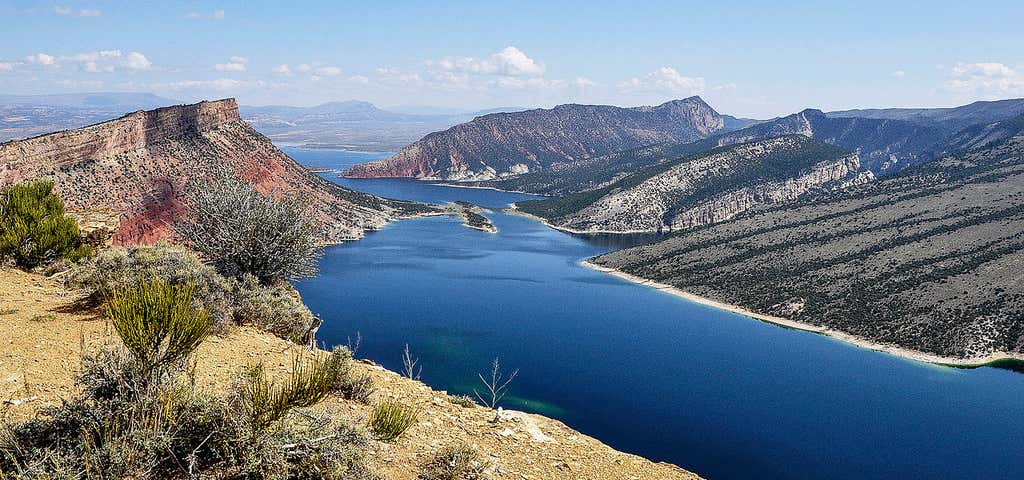Written by Cassandra Brooklyn
With only about half a million residents, Wyoming has the distinction of being the least-populated state in the country—but what it lacks in population, it makes up for in natural beauty and attractions. Though you’ll find unique museums, roadside attractions, and breathtaking scenery stretching to all four corners of the state, the western edge of the Cowboy State has the densest concentration of significant sites.
From Native American petroglyphs to hot springs and two of the most popular national parks in the country, Wyoming is just begging to be explored. Here are 10 of our favorite things to do on a road trip across western Wyoming.
Peering out over the now dry and arid landscape, it’s hard to believe that this portion of the southwest used to be jungle-like. However, the Fossil Butte National Monument in Kemmerer serves as a living fossil aquarium, forever preserving the remnants of fish, insects, reptiles, birds, mammals, and plants that used to live in this former prehistoric lake. For those wanting to stretch their legs a bit more, several trails are spread around the site.
2
Worlds Largest Elkhorn Arch
The small town of Afton, Wyoming, has, quite possibly, the most Wyoming attraction you’ll find in the entire state: an enormous arch made entirely of elk antlers. Constructed of more than 3,000 intertwining elk antlers—and spanning across all four lanes of U.S. Route 89 through the town’s small downtown—the arch is estimated to weigh more than 15 tons. Though there is a smaller (yet better-known) elk antler arch in Jackson, Afton’s antler arch is believed to be the largest in the world. And rest assured that no elk were harmed during the arch’s construction—it includes naturally-shedded antlers collected from the National Elk Refuge near Jackson.
3
Snow King Mountain
During summer months, head to Snow King Mountain to ride the Summer Cowboy Coaster rollercoaster that takes you on a mile-long ride of loops, twists, and turns through wildflower meadows. Beginning in December, Snow King Mountain switches things up a bit with the Winter Cowboy Coaster, allowing you to speed past skiers and snowmobilers. Regardless of when you visit, the ride will be thrilling and treat you to breathtaking views of the Teton mountains.
As it’s one of the most-visited national parks in the U.S., it’s best to plan your visit to Grand Teton during off-peak times to avoid the crowds. If you’re driving up from Jackson, pop into the Moose Entrance Visitor Center to speak with rangers to determine which hiking, biking, and driving routes best suit your interests and mood. Taggert and Jenny lakes (and the Hidden Falls waterfall) are two of the most beautiful—and most-visited—parts of the park, so try to get on the trails before 9 a.m. Note that western Wyoming is bear country (both black and grizzly) so if you plan to hike, be sure to pack bear spray.
5
Yellowstone National Park
Established in 1872, Yellowstone is the oldest national park in the country. Though small portions of it extend into Idaho and Montana, the vast majority of the park’s 2 million acres are spread across northwestern Wyoming. The park is best known for boiling mud pots and brilliantly-colored geothermal hot springs such as Old Faithful and Grand Prismatic Spring, and for its superb wildlife viewing. Check with visitor center staff and park rangers to learn where elk, bison, wolves, and bears have been spotted recently—or sign up for a guided day tour of the park with a company like EcoTour Adventures (advance registrations are required). Just like in Grand Teton, you’ll want to bring bear spray with you when hiking.
6
Granite Hot Springs Road
Inside the Bridger-Teton National Forest is a natural hot spring pool with spectacular views of the surrounding spruce, pine, and fir trees. Granite Hot Springs are open year-round and can be accessed by dogsled, snowmobile, or skis in the winter for anyone not wanting to drive the mountain curves in the snow. This place can get crowded so arrive as early as possible, particularly on weekends. Hours vary by season so check the website before planning your trip.
If you’d like to visit hot springs on the way to Jackson with less of a detour, Astoria Hot Springs are located right on Highway 89 (and can be seen from the road), about 30 minutes before you get to Jackson.
National forests are often passed over for more popular national parks, which means that those in the know can often enjoy the woods all to themselves. The Bridger Wilderness area extends 80 miles along the Continental Divide in a mountainous region blanketed with alpine glacial lakes and sweeping valleys. The Green River Lake trail is a gorgeous hiking option here; the most impressive sites—snow-capped mountains reflecting onto turquoise-green lakes—are accessible within the first few miles.
Note that since this is a wilderness area, there are no restaurants, shops, or cabins, so you’ll need to bring food and water with you (or bring a water filter to fill in the river and lake). As this is bear country, you’ll also want to bring bear spray and know some basic bear safety tips. Unless you plan on camping, good overnight options would be the Lakeside Lodge in Pinedale (90 minutes to the south) or the Kodiak Mountain Resort in Afton (3 hours west).
8
Farson Mercantile
Known across the state as the “Home of the Big Cone,” Farson Mercantile is the perfect place to stop for a sweet treat. For more than 30 years, “the Merc” has been dishing out ice cream, espresso, pizza, and deli sandwiches to the town’s 325 residents and tourists alike. In addition to food and coffee, Farson’s has a small gift shop and general store where you can stock up on everything from batteries and basic groceries to greeting cards and Wyoming-themed souvenirs.
9
White Mountain Petroglyphs
The sandstone etchings of the White Mountain Petroglyphs are a permanent reminder of the earliest human inhabitants of the region now known as Sweetwater County. To reach the petroglyphs, take U.S. 191 about 10 miles north of Rock Springs, then turn right at CR 4-18 (at the sign that reads “Petroglyphs, Sand Dunes, Boar’s Tusk”). Turn left at CR 4-17 and drive about 14 miles on the dirt road until you reach the sign for the White Mountain Petroglyphs. Turn left onto another dirt road and drive about 2 miles to the Bureau of Land Management (BLM) parking lot. From here, hike about a quarter mile to reach the petroglyphs.
Note that the petroglyphs are located in an off-grid, very remote location so make sure you have extra water, a reliable GPS system, and handy maps since it’s unlikely that you’ll have cell service. A four-wheel-drive vehicle with a high tire-clearance is recommended.
10
Flaming Gorge Reservoir
Unlike national parks, which tend to get all the attention, national recreation areas are often just as impressive—and with smaller crowds. Made of stunning red canyon walls and arid green forest, the Flaming Gorge National Recreation Area stretches across more than 200,000 acres of wilderness, offering hiking, biking, fishing, and camping opportunities. The most popular destination within the recreation area is the 91-mile Flaming Gorge Reservoir, which extends from Green River and Rock Springs, Wyoming, all the way into Utah. The 100-mile stretch of Highway 91 that parallels the gorge is known as the Flaming Gorge Scenic Byway—enjoy the views and be sure to stop at the Firehole and Clay Basin overlooks along the way.
Banner Photo Credit: Wikimedia Commons
Roadtrippers
Roadtrippers helps you find the most epic destinations and detours—from roadside attractions to natural wonders and beyond.
Explore More Trip Guides
A Highway 1 road trip along California’s Central Coast
- 14 Places
- 02:49
- 99 mi
Route 66 Leg 2: St. Louis to Tulsa
- 61 Places
- 18:31
- 876 mi
Route 66 Leg 1: Chicago to St. Louis
- 71 Places
- 16:31
- 636 mi
Route 66 Leg 3: Tulsa to Amarillo
- 94 Places
- 18:36
- 867 mi












